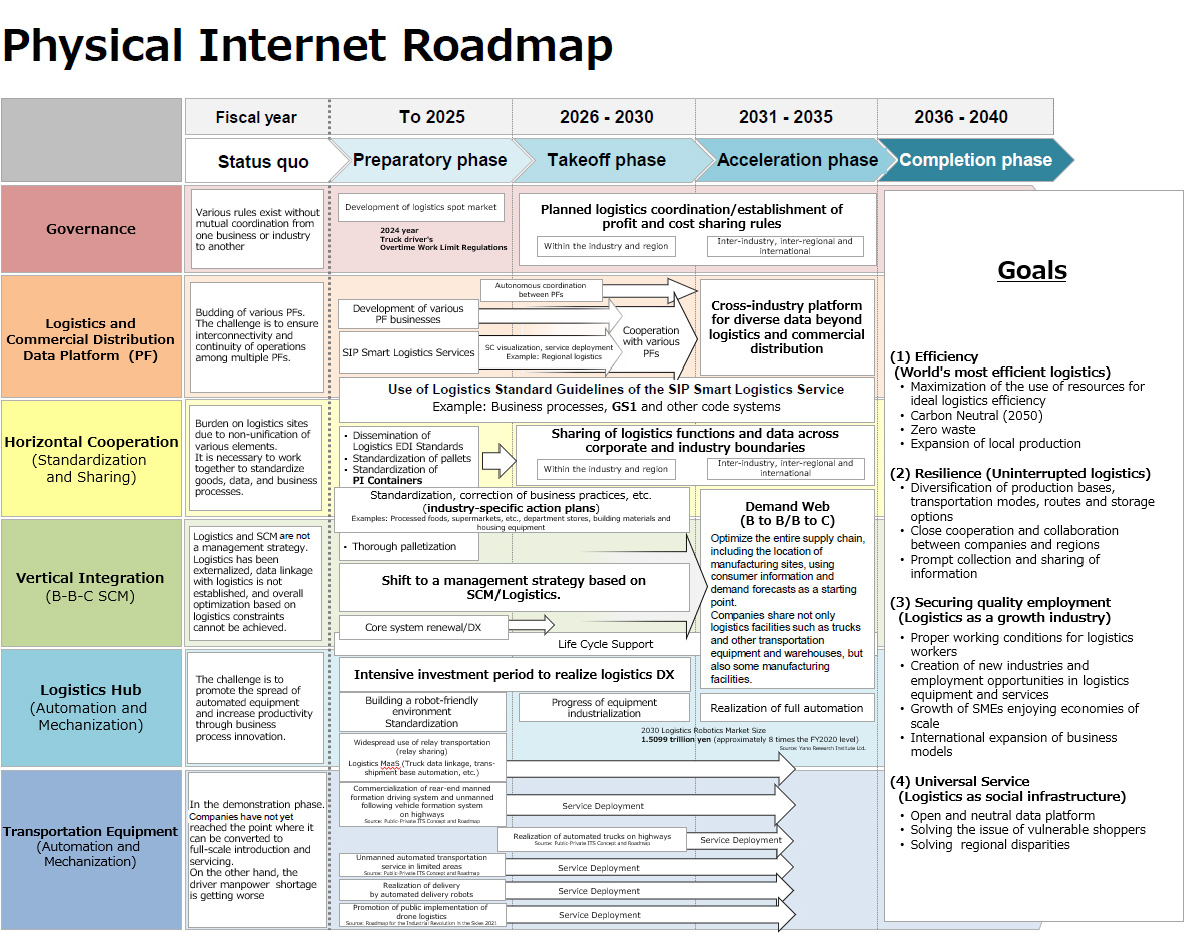The fact that there was a lot of overwork and waste in the process was also a major factor in the logistics crisis
The 1990 law revision eased the regulations on the motor truck transportation business in Japan, and the permission system was introduced instead of the licensing system. Afterwards, some relevant factors caused an increase in the number of trucking companies from about 40,000 to about 60,000, resulting in severe competition. However, difficulty in improving efficiency and severe competition for cargo prevented transport cost increases. Consequently, truck drivers were forced to work long hours at low wages, which made young people reluctant to become drivers. Japan is already facing an aging population with declining birthrate, and the shortage of drivers has become serious.
In order to curb long working hours, the Standards for Improving Working Hours of Motor Vehicle Drivers were revised in 2022 and drivers’ overtime hours have been restricted since April this year. However, if the current situation continues, it is estimated that there will be a shortfall of up to about 14% in transportation capacity in 2024 and about 34% by 2030, compared to that in 2019.
The fact that there was a lot of overwork and waste in the process was also a major factor in the logistics crisis. Japan has a business structure whereby manufacturing, distribution and sales businesses operate independently. This means that the processes of delivering goods are divided into the phases of manufacturers, wholesalers, and retailers. Having multiple stages has had bad impacts on worksites in distribution. Another problem is that the average loading efficiency of trucks is currently less than 40%. That means about 60% of the cargo carried by trucks is air. To make things worse, when a truck arrives at the buyer’s (shipper’s) distribution center, there is a long line of trucks waiting for unloading and cargo inspection. It takes a long time and the driver has to wait for hours.
In Japan, in the first place, sellers are responsible for delivering goods to buyers’ places of business, and often transaction prices do not specify distribution cost. As a result, the perspective of streamlining physical distribution has not been focused on much. Also, since the transportation industry has a multiple structure with prime contractors and subcontractors, the actual conditions of transportation are not fully understood, which many have exacerbated the problem.
On the other hand, in a large country such as the United States, where long-distance transportation is burdensome, shipper companies operate business on the premise that they streamline distribution in order to overcome severe conditions for product procurement. For example, Walmart, the world’s largest retailer, has systemized inventory placement and transportation methods according to the volume of goods shipped and sold, which is linked with store shelf allocation and stacking. In other words, the logistics, which is a mechanism to centrally manage distribution, is designed to be integrated into the core of its business system.
In the United States, under the Robinson-Patman Act of 1936, goods on the same terms and conditions must be traded for the same price, so it may have been necessary to incorporate logistics efficiency into business operations. Since both manufacturers and retail chains in the U.S. are more oligopolistic than in Japan, and large manufacturers and large retail chains trade directly, we can say that trading rules incorporating the logistics are more likely to be formed.
The Physical Internet that delivers cargo by relaying it between logistics hubs
To be prepared for the 2024 Problem, the government has established policies that stimulate changes in shippers’ and consumers’ actions to contribute to the promotion of distribution efficiency. But in essence, the distribution basis should be shared efficiently so that it can be maintained as industrial and social infrastructure. The new system for realizing it is called Physical Internet.
Physical Internet is a concept advocated by Western intellectuals around 2010. Taking a hint from packet communication of the information Internet, the idea is to apply the same system to distribution. It aims at creating an efficient distribution network by combining packages in standardized forms and delivering them between distribution bases like running in a relay race. This is expected to help rapid rerouting in the event of a disaster and CO2 reduction.
In Europe and the United States, giant companies operate business in an oligopolistic market, so private sectors have taken the lead in forming cooperative organizations to create rules. On the other hand, in Japan, not only are there many players involved, but also in many cases, a relationship between a seller and a buyer is very complicated with wholesalers interposing between them. Therefore, it is difficult for the private sector alone to make rules.
Addressing to this issue, Japan’s national government has taken the lead, as the first case in the world, in achieving the standardization of various matters in all businesses involved in streamlining distribution and supply chains. In March 2023, under the leadership of the government, ministries and agencies such as the Ministry of Land, Infrastructure, Transport and Tourism and the Ministry of Economy, Trade and Industry, worked together to announce the “Roadmap for the Realization of Physical Internet by 2040.” I also participated as a member of the realization committee.
In the first place, it is not easy to achieve the Physical Internet, which requires collaboration within an industry of competitors. In addition to the roadmap, the Ministry of Economy, Trade and Industry decided to develop action plans for each industry to encourage specific actions. As the chairperson of the committee, I complied action plans for the processed food and daily necessities industry by 2030.
When we started formulating plans, we were faced with the following issues: the reluctance to share information with competitors, which size should be used for standardized pallets for loading, who should invest in materials and equipment for distribution, and who should make operational rules. We have decided to standardize office codes and product masters, establish a data base for distribution and commercial flow and make its operational rules, standardize distribution materials such as pallets and containers, and review business practices that affect distribution efficiency. We are now working on developing these action plans in other industries as well.
Connecting across companies, industries, and regions to create a shared platform
The Roadmap for the Realization of the Physical Internet by 2040 lists several items for achieving the goal. They show the steps to form a shared platform, by reducing inefficient practices and procedures in a supply chain, and creating a network of streamlined distribution and logistics that connects across companies, industries, and regions.

Trade and Industry(2022), “Roadmap for Realizing the Physical Internet”, p8.
In forming the Physical Internet, the most important items are horizontal cooperation and vertical integration. The current distribution network is inefficient because each company and industry has a closed network. As supply chains and distribution platforms are to be controlled by digital information, a data platform that connect commercial transactions and distribution data is required.
In addition, owing to the chronic staff shortage in distribution worksites, we will actively promote mechanization and automation of transport (trucks) and bases (warehouses). It is also necessary to make rules to efficiently match them to shippers according to their requests by using these systems.
The Roadmap aims to realize the Physical Internet by around 2040 by gradually introducing these initiatives. The approaches for the 2024 problem led to the movement to create the conditions for improving logistics efficiency. In February this year, the Cabinet approved a draft law that stipulates the obligation for shippers and distribution operators to streamline distribution processes.
With a declining population in Japan, these problems are not limited to delivery and other related industries. We are consumers and also workers. While we can purchase cheap products online and enjoy convenient services, workers involved in making these possible are exhausted. Can’t we say that this is a situation where a person bears a significant contradiction? We also need to review the issue in terms of a sustainable society and industries. I think we need to recognize again that convenient life styles are imposing a heavy burden on workers in the industry.
* The information contained herein is current as of May 2024.
* The contents of articles on Meiji.net are based on the personal ideas and opinions of the author and do not indicate the official opinion of Meiji University.
* I work to achieve SDGs related to the educational and research themes that I am currently engaged in.
Information noted in the articles and videos, such as positions and affiliations, are current at the time of production.


